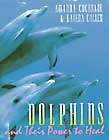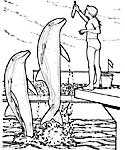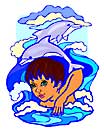We'd like to hear from you.
 

Write to

Don't miss these wonderful books:
Dolphins and Their Power to Heal
by Amanda Cochrane, Karena Callen

I read this book before my swim with the wild dolphins in the Bahamas and it gave me an even greater appreciation for what I was doing and enjoying. The chapter on the myths and evolution was so enlightening. The book inspired me to connect more with my world. I have passed this book on to others whose work is to research and direct swim trips with dolphins.
Dolphin Chronicles
by Carol J. Howard

I'm a 14 year old girl, and I thoroughly enjoyed this book! I love dolphins, and I wanted to learn more about them. Dolphin Chronicles presents lots of information. You'll have a much greater understanding of dolphin training, their lifestyles in captivity and in the wild, and the life of a person working with dolphins. It's great that this book can be so easy to read and comprehend. I totally recommend it to anyone who would like to understand the dolphin world better!
If you love your dog

Buy All-Natural & Holistic Stuff for Your Dog at Just4Pooches
|
 Dolphins: Are They the Reincarnation of Scientists Lost At Sea? Dolphins: Are They the Reincarnation of Scientists Lost At Sea?
by Marjorie Dorfman
What is it about these intelligent creatures that is so endearing? Why do they always seem to smile? Read on for some insight into an amazing natural phenomenon.
The difference between genius and stupidity is that genius has its limits. – Anonymous
Although dolphins probably aren’t the reincarnation of anything besides dolphins, their superior intelligence does make one wonder about just exactly where they came from and why they are here. There is something about this remarkable mammal that stirs the hearts of even the most ambivalent animal watchers. Perhaps it is the trust and vulnerability that seem to live behind that eternal smile. The dolphin’s amiability touches us in a special way and encounters with them are an enriching experience; leaving us with a fascinating awareness that was not there before. The Day of the Dolphin and Flipper are but the tip of the proverbial iceberg. While it wasn’t nice that an iceberg sank the Titanic, this symbol of unseen, unknown dimensions could not be more apt than in this reference to one of nature’s most unusual animals.
 Dolphins are one of many marine animals that inhabit the sea, others being manatees, porpoises, otters, sea lions and whales. Whales, dolphins and porpoises belong to the order called Cetacea, which can be further divided into three smaller suborders. The Archaecetes were the ancient whales and are now extinct. The second group, Mysticetes, includes, among others, the gigantic blue, grey and humpback whales. Instead of teeth, they have a series of comb-like plates called baleen, which they use to strain plankton and shrimp from the water as a food source. The largest suborder is the Odontocetes, also known as the toothed whales, which includes sperm whales, belugas and dolphins. The number of teeth may vary with the species, but all use their teeth for catching, not chewing food. There are ten different families of toothed whales. (And not one of them lives near a dentist!) Dolphins are one of many marine animals that inhabit the sea, others being manatees, porpoises, otters, sea lions and whales. Whales, dolphins and porpoises belong to the order called Cetacea, which can be further divided into three smaller suborders. The Archaecetes were the ancient whales and are now extinct. The second group, Mysticetes, includes, among others, the gigantic blue, grey and humpback whales. Instead of teeth, they have a series of comb-like plates called baleen, which they use to strain plankton and shrimp from the water as a food source. The largest suborder is the Odontocetes, also known as the toothed whales, which includes sperm whales, belugas and dolphins. The number of teeth may vary with the species, but all use their teeth for catching, not chewing food. There are ten different families of toothed whales. (And not one of them lives near a dentist!)
Although many people often confuse the two, dolphins and porpoises represent two different families of toothed whales. Porpoises are generally smaller than dolphins, darker in color and found in deeper and cooler waters. They usually lack the rostrum or bottlenose that dolphins almost always have. There are about thirty species of dolphins found in our oceans, a few being the white-sided, spotted and bottlenose. It is the Atlantic Bottlenose, Tursiops truncatus, that is most well known to people who remember Flipper and Alpha and Beta, (Fa and Bee to their nearest and dearest), from the Mike Nichols film, The Day of The Dolphin. The Latin name, tursiops truncatus, means "an animal like the dolphin with a cut off face." Their pectoral fins contain five digits and the same number of bones found in a human arm from the fingertips to the shoulder. This, with the support of other evidence, indicates that dolphins migrated back into the oceans about 53.5 million years ago.
The Atlantic Bottlenose Dolphin can be found throughout the temperate, tropical and sub-tropical waters of the Atlantic Ocean. They tend to live in the shallower areas in which people frequently swim and boat. With a great deal of variety in size, appearance and behaviors, these dolphins are further divided into about nine different sub-species. The bottlenose dolphins found in the United Kingdom may weigh up to 1200 pounds and migrate shorter distances to locate food or avoid predators. In the shallow Bahamian waters, these creatures can grow as much as nine feet in length, weighing up to 500 pounds. The average life span of this species is approximately thirty years (or nine years over the age of consent).
 Dolphins thrive under human care and supervision. They breed successfully, form complex social groups known as pods, consume high quality nutritional food and are kept free of debilitating parasites. In marine parks and aquariums where dolphins are the chief attractions and performers, they are protected from the dangers of pollution, predators and natural events such as El Nino, which triggered food shortages for many marine animals in the late 1990s. Advances in animal care and medicine have greatly contributed to the improved health of the species, as well as to the successful rehabilitation and release of stranded or injured animals. Dolphins thrive under human care and supervision. They breed successfully, form complex social groups known as pods, consume high quality nutritional food and are kept free of debilitating parasites. In marine parks and aquariums where dolphins are the chief attractions and performers, they are protected from the dangers of pollution, predators and natural events such as El Nino, which triggered food shortages for many marine animals in the late 1990s. Advances in animal care and medicine have greatly contributed to the improved health of the species, as well as to the successful rehabilitation and release of stranded or injured animals.
Why do dolphins always seem to smile? (Let’s face it. No one can be happy all the time, not even a dolphin!) This effect is due to the bottlenose or rostrum, which is a bony extension of the skull. Dolphins rely on it to touch and move objects since they don’t have hands. They do not chew their food and the eighty-eight to one hundred and twenty conically shaped teeth inside the mouth are used to grasp prey before swallowing it whole. A dolphin’s stomach is highly acidic, capable of digesting whole foods. They are what is known as "catholic feeders", which means that they eat whatever species of fish is available. Primarily they eat schooling fish (not Catholic school), but rather herring, mackerel, mullet or capelin to name a few. They also eat crustaceans and mollusks, such as squid and shrimp.
The blowhole on top of the dolphin’s head is its nose and the source of its breathing. Dolphins can remain submerged up to eight minutes, but generally take a breath every thirty seconds. The blowhole, not the mouth, is also the only place from which sounds come. Beneath the opening of the blowhole are three pairs of nasal air sacs and by squeezing air from one sac to another, dolphins produce sounds. Vocalizations are broken down into three main types: buzzes, clicks and whistles.

Dolphins have several acute senses. Their eyesight is as good as a human’s and they never need glasses or contact lenses to boot. They have the ability to compensate for the refraction of light waves, allowing them to see well both above and below the surface of the water. They do not have a sense of smell, but offset this with a highly developed sense of hearing. Above the water they are capable of hearing a wide range of frequencies. The pinhole opening located about two inches behind the eye is the external opening to the ear canal.
Below the surface, dolphins utilize a system known as echolocation or biosonar. They emit bursts of high frequency sounds from the forehead or melon, which then bounce off objects and return to the dolphin in the form of echoes. Each echo is absorbed through the hollow lower jaw and transmitted via a fatty fluid to an acoustic window and then to the inner ear. When the dolphin processes the sounds, it can distinguish the size, shape density, distance and speed of an object. Echolocation is helpful in the wild as it is used for navigation, finding food, avoiding predators and communication with other dolphins.
Dolphins are also patriotic and do not shirk wartime duty. They do so without enlisting, receiving purple hearts, fringe benefits, pension plans or life insurance. The US Navy has been using marine mammals to protect American divers since the Vietnam War. Dolphins are uniquely suited for numerous missions including mine detection. They are trained to mark the mines, which are made of metal with floating buoys. Navy divers detonate the mines after the dolphins have been removed from the area, but animal activists do not like the idea of dolphins being drafted. According to Stephanie Boyles, wild life biologist for People for the Ethical Treatment of Animals, "war is a human endeavor and innocent animals should not be put in harm’s way. Dolphins were meant to live and die in the water and not take plane trips to the Middle East. To them, finding mines is a game and they don’t know the consequences if they fail."

The dolphin’s nature is altruistic. They work cooperatively in hunting for food and always display the best table manners. According to the Dolphin Research Center in the Florida Keys, the males will support an injured dolphin at the surface so that it can breathe and entire pods will put themselves in jeopardy to come to the aid of a mother and her calf. Maybe they aren’t the reincarnation of anything other than toothed whales, but can anyone really say that they have seen Isaac Newton, Albert Einstein or Enrico Fermi lately?
Did you know . . . ?
|
|